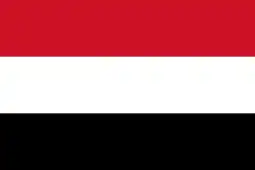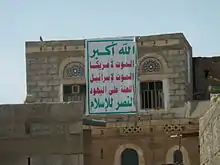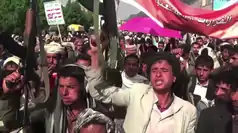 God is the Greatest
Death to America Death to Israel A Curse Upon the Jews Victory to Islam | |
| Use | Slogan, rallying symbol |
|---|---|
| Proportion | 75:53 (1.414) (varies by size) |
| Adopted | c. 2003 |
| Design | Vertical white banner with a green border and five Arabic statements from top to bottom in the centre: green text for pro-Islamic statements and red text for anti-American, anti-Israeli, and antisemitic statements. |
The slogan of the Houthi movement (officially called "Ansar Allah"), a Shia Islamist political and military organization in Yemen, reads "God Is the Greatest, Death to America, Death to Israel, A Curse Upon the Jews, Victory to Islam" (Arabic: ٱللَّٰهُ أَكْبَرُ, ٱلْمَوْتُ لِأَمْرِيكَا, ٱلْمَوْتُ لِإِسْرَائِيلِ, ٱللَّعْنَةُ عَلَیٰ ٱلْيَهُودِ, ٱلنَّصْرُ لِلْإِسْلَامِ Allāhu ʾakbar, al-mawt li-ʾAmrīkā, al-mawt li-ʾIsrāʾīl, al-laʿnah ʿalā 'l-Yahūd, an-naṣr lil-ʾIslām) on a vertical banner of Arabic text. It is often portrayed on a white flag, with the written text in red and green; the pro-Islamic statements are coloured green while the statements about the United States, Israel, and the Jewish people are coloured red.
Background


Modeled on a motto from revolutionary Iran,[1] the slogan "Allah is the Greatest, Death to America, Death to Israel, A Curse Upon the Jews, Victory to Islam" was originally not tied to the Houthi movement. Its exact origin is disputed. Some sources state that it was first chanted at the Imam al-Hadi school in Marran in January 2002, while others claim that Hussein Badreddin al-Houthi used it after seeing footage of a young Palestinian dying in his father's arms during the Second Intifada in 2000.[2]
The slogan eventually became a sign of public protest against the dictatorship of Yemeni President Ali Abdullah Saleh. It was first widely used during a visit by Saleh to Saada in January 2003. At the time, the President intended to make a speech during the Friday prayers, but was drowned out by locals who chanted the slogan to protest against his policies. The Yemeni government responded with a crackdown, and 600 people were arrested for having used the slogan. This only worsened the situation, and the slogan spread in northern Yemen.[2]
The Houthi movement officially adopted the slogan in the wake of the 2003 U.S. invasion of Iraq, which was widely condemned in the Arab world.[3] This brought the movement on a collision course with the government, as the government maintained its official pro-American politics despite public opposition. The slogan was outlawed. The Houthis refused to discard it, arguing that the constitution of Yemen protected free speech. By 2004, crackdowns against both the slogan as well as the Houthi movement intensified. Many Houthis were imprisoned and even tortured for having used it. The conflict between the Houthis and the government eventually resulted in the outbreak of a violent insurgency in the northern part of the country.[2]
Despite the religious overtones of their slogan, the Houthis self-identify as Yemeni nationalist group opposed to the oppression of all Yemenis, including Sunni Muslims, by foreigners.[4][5][6] Though the slogan is the most prominent symbol of the Houthi movement, often displayed on placards and flags, the Houthis also display the regular flag of Yemen as a rallying symbol.[7]
Some Houthi supporters state that their ire for the U.S. and Israel is directed toward the respective countries' governments. Ali al-Bukhayti, the spokesperson and official media face of the Houthis, rejected the literal interpretation of the slogan by stating in an interview: "We do not really want death to anyone. The slogan is simply against the interference of those governments [i.e., U.S. and Israel]."[8] In the Arabic Houthi-affiliated TV and radio stations they use religious connotations associated with jihad against Israel and the US.[9]
After the Houthi's October 2023 declaration of war against Israel, a tricolor flag of three equal horizontal stripes, black, white, and green from top to bottom, overlaid by a red triangle issuing from the hoist has been observed in different instances, alongside the slogan and flag of Yemen.[10][11][12][13][14][15] Historically this flag have been associated with Arab Revolt as a pan-nationalistic symbol to unite the Arab nations, later it was associated with All-Palestine Government and Army of the Holy War.
This probably depicts the flag of Palestine and therefore adoption of the flag would be a sign of solidarity in this regard. However, there have been instances of Arab nationalism as a rallying point in Houthi rhetoric alongside their usual religious ethos.[16][17][18][19][20]
Gallery
 A building in Dhamar, Yemen, bearing the Houthi slogan banner
A building in Dhamar, Yemen, bearing the Houthi slogan banner Protesters in Sanaa, Yemen, with placards of the Houthi slogan
Protesters in Sanaa, Yemen, with placards of the Houthi slogan
See also
References
- ↑ ShahidSaless, Shahir (30 March 2015). "Does Iran really control Yemen". Al-Monitor. Archived from the original on 13 February 2015.
- 1 2 3 Winter, Lucas (2011). "Conflict in Yemen: Simple People, Complicated Circumstances". Middle East Policy. XVIII (1): 102–120. doi:10.1111/j.1475-4967.2011.00476.x.
- ↑ Riedel, Bruce (18 December 2017). "Who are the Houthis, and why are we at war with them?". Brookings Institution. Retrieved 20 April 2019.
- ↑ Asher Orkaby (25 March 2015). "Houthi Who? A History of Unlikely Alliances in an Uncertain Yemen". Foreign Affairs. Retrieved 20 April 2019.
- ↑ Cameron Glenn (29 May 2018). "Who are Yemen's Houthis?". Wilson Center. Retrieved 20 April 2019.
- ↑ Rai, Manish (13 April 2018). "Iran Developing Houthis as its Long-Term Asset". International Policy Digest. Retrieved 20 April 2019.
- ↑ Ridgwell, Henry (4 September 2015). "Yemen Fighting Intensifies as Fears Grow of Sectarian Conflict". Voice of America. Retrieved 20 April 2019.
- ↑ "Photo Essay: Rise of the Houthis". Newsweek. 9 February 2015. Retrieved 27 March 2015.
- ↑ Taqi, Abdulelah (12 April 2015). "Houthi propaganda: following in Hizbullah's footsteps". The New Arab. Retrieved 15 October 2016.
- ↑ "Yemen's Houthi rebels seize cargo ship in Red Sea". Al Jazeera English. 19 November 2023. Retrieved 28 December 2023.
- ↑ "Yemenis put aside their woes to unite for Gaza and Palestine". The New Arab. 19 October 2023.
- ↑ Balawi, Mohammad Makram (21 December 2023). "The Houthis are turning the tables on everyone". Middle East Monitor.
- ↑ "Houthi missile hits Norwegian tanker in Red Sea; ship reportedly en route to Israel". The Times of Israel. 12 December 2023.
- ↑ "Israeli ships 'legitimate target,' Huthis warn after seizure". L'Orient Today. 20 November 2023.
- ↑ "Yemen's Houthis declare joining Israel-Hamas war". India Today. 31 October 2023.
- ↑ Palik, Júlia (2017). "'Dancing on the heads of snakes': The emergence of the Houthi movement and the role of securitizing subjectivity in Yemen's civil war". Corvinus Journal of International Affairs. 2 (2–3): 42–56. doi:10.14267/cojourn.2017v2n2a4.
- ↑ Alziady, Hesham (2021). "How can the Houthi Ethnic Supremacy Beliefs Undermine the Social and Political Stability in Yemen?". International Journal of Advance Research, Ideas and Innovations in Technology. 7 (2): 802–813.
- ↑ "Houthis". Sabwa Center. 7 October 2022. Retrieved 18 September 2023.
- ↑ Glenn, Cameron (29 May 2018). "Who are Yemen's Houthis?". Woodrow Wilson International Center for Scholars. Archived from the original on 20 April 2019. Retrieved 1 January 2024.
- ↑ Farrell, Stephen (13 August 2020). "Israel hails UAE deal but Palestinians – and settlers – dismayed". Reuters. Archived from the original on 15 November 2020. Retrieved 9 September 2020.